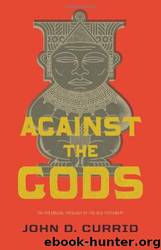Against the Gods: The Polemical Theology of the Old Testament by John D. Currid

Author:John D. Currid
Language: eng
Format: mobi, epub
Tags: Religion, Christian Theology, General
ISBN: 9781433531835
Publisher: Crossway
Published: 2013-03-15T21:06:19.694000+00:00
6
The Birth of the Deliverer
As will become clear in our study, numerous stories from the Old Testa1 of the ancient Near East. One
of those motifs that is found in various cultures of the area is a birth story
in which a child is under threat and danger in infancy, but he survives and
grows up to become an important leader of his people. Most of these stories are mythic narratives or legends that deal with the lives of the gods or
of larger-than-life human heroes. The various versions of the motif cover
a long span of time: the earliest version perhaps appears as early as the
end of the third millennium BC. The motif is found throughout the ancient Near East, including accounts from Mesopotamia, Egypt, and Hatti.
Important for our investigation is the fact that there are striking parallels
between the birth story of Moses recorded in Exodus 2:1–10 and these
other stories. The question for us, once again, is how do we evaluate and
understand the relationship of these ancient Near Eastern tales and the biblical narrative? Is there dependence between them? Is the biblical author
merely borrowing well-known literature from the surrounding cultures and
employing it for his own purposes? Is the biblical material legend, myth, or
history? These and other questions will be dealt with in the course of this
1Term used by Dorothy Irvin, “The Joseph and Moses Story,” in Israelite and Judaean History, ed. John H.
moves the story forward a step.”
describe and consider the various accounts of the “birth of the deliverer” motif in the ancient Near East.
The Legend of Sargon
Sargon I (c. 2340–2284 BC) was a Semite who was the founder of the Akkadian empire in Mesopotamia. “He had been cupbearer to the king of Kish, but he overthrew his master and then marched his forces to Uruk. Sargon defeated Lugalzaggisi who, at that time, was overlord of Sumer,
to the Persian Gulf. He founded his capital at the city of Agade, the only royal city of ancient Mesopotamia whose location is unknown.” 2 Sargon expanded his land holdings with military campaigns against Syria in the
accounts his reign was a glorious one.
We do not have much contemporary inscriptional evidence from the reign of Sargon; there are two Sargon texts that describe his military expansion to the east, in particular, against Elam.3 Sargon was certainly concludes, and Tremper Longman agrees, that it was originally written during the reign of Sargon II (721–705 BC) in the neo-Assyrian period.6 The purpose of the tale was to glorify Sargon II by showing that he was a worthy successor of Sargon I of Akkad. In other words, the text was partially composed to legitimize the rule of Sargon II. That chronology certainly is possible, although it is speculative. Some of the elements of the legend are found in other texts that precede the full accounts of the seventh–sixth centuries BC. For example, one Old Babylonian text (early second millennium BC) begins, “I am Sargon, the beloved of Ishtar, who roams the entire world.” 7 The idea that Sargon is the beloved one
Download
Against the Gods: The Polemical Theology of the Old Testament by John D. Currid.epub
This site does not store any files on its server. We only index and link to content provided by other sites. Please contact the content providers to delete copyright contents if any and email us, we'll remove relevant links or contents immediately.
| Exegesis & Hermeneutics | New Testament |
| Old Testament |
The Five People You Meet in Heaven by Mitch Albom(2843)
Name Book, The: Over 10,000 Names--Their Meanings, Origins, and Spiritual Significance by Astoria Dorothy(2491)
Real Sex by Lauren F. Winner(2476)
The Holy Spirit by Billy Graham(2418)
The Secret Power of Speaking God's Word by Joyce Meyer(2253)
0041152001443424520 .pdf by Unknown(2220)
How The Mind Works by Steven Pinker(2214)
Ancient Worlds by Michael Scott(2103)
ESV Study Bible by Crossway(2097)
The Meaning of the Library by unknow(2069)
The Gnostic Gospels by Pagels Elaine(2027)
Churchill by Paul Johnson(2013)
MOSES THE EGYPTIAN by Jan Assmann(1972)
The ESV Study Bible by Crossway Bibles(1916)
Jesus by Paul Johnson(1887)
The Nativity by Geza Vermes(1849)
Ancient Near Eastern Thought and the Old Testament by John H. Walton(1849)
The Complete Dead Sea Scrolls in English (7th Edition) (Penguin Classics) by Geza Vermes(1842)
City of Stairs by Robert Jackson Bennett(1826)
